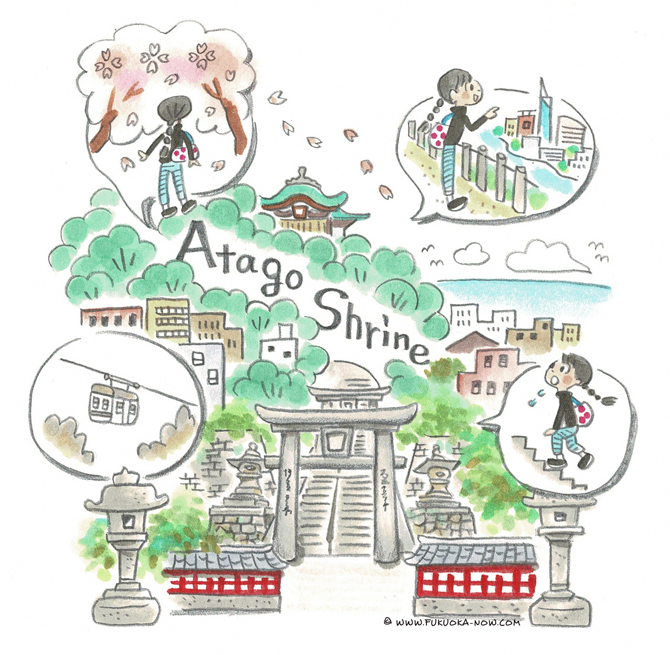Hakata Culture vol.169
Cherry Blossoms and Beautiful Night Views at Atago Shrine

Not far from the bay, Atago Shrine is located on top of Mt. Atago in Nishi Ward. From its hilltop perch, the shrine affords visitors panoramic views of the Momochihama district, whose skyline is dominated by the Fukuoka Tower, and the Genkai Sea. The headquarters of Atago Shrine is located in Sakyo Ward in Kyoto, and together with the Atago Shrines in Minato Ward (Tokyo) and Kasama City (Ibaraki Pref.), Fukuoka’s Atago Shrine is considered one of Japan’s “big three” Atago Shrines. Dedicated to the god of fire, the Atago Shrines throughout Japan are all located on mountaintops and have long, steep sets of stairs.
Atago Shrine sits on the site of Fukuoka’s oldest shrine, Washio Shrine, which was built in the year 72. As such, the mountain came to be called Mt. Washio. In 1634, during the Edo era, the second lord of the Fukuoka Domain, Tadayuki Kuroda, had Atago Shrine built after organizing the transfer of a divided deity from the main shrine in Kyoto. A few centuries later, in 1901, Washio and Atago Shrines were merged into the Atago Shrine we know today. The deity at Atago Shrine is said to answer prayers for good luck, longevity, prosperous business and safety from fire, and more recently, it has become a popular spot to pray for good fortune in love.
There are several approaches to the shrine, including the steep stone stairs called otokozaka (“men’s slope”) and a gentle switchback route called onnazaka (“women’s slope”). There also used to be a ropeway. The ropeway, which opened in 1928, was the first in Kyushu and just the second in Japan. It connected the foot of the hill to the shrine in about two minutes. However, the cable car was forced to shut down during World War II when the cars and cables were appropriated for the war effort.
Atago Shrine is also well-known for its stunning night views, and with around 2,000 cherry trees on the grounds, it is one of Fukuoka’s popular blossom viewing spots. There are several varieties of cherry tree, including early blooming and late blooming ones, so visitors can enjoy cherry blossoms for a relatively long time from mid-March to mid-April. Atago Shrine is one of only a few places where you can enjoy cherry trees lit up at night alongside the city nightscape.
桜と夜景が素晴らしい愛宕神社
海に近い愛宕山の頂上にある福岡市西区の愛宕神社。小高い山の上からは、福岡タワーなどがある百道浜地区から玄界灘一帯が眺められる絶景スポットです。愛宕神社の総本山は京都市右京区にあり、東京都港区および福岡市の愛宕神社を加えて日本三大愛宕と呼ばれています。愛宕神社は火の神様を祭る神社で、いずれも山の上にあり、急峻な階段があることも共通しています。
もともとこの地には福岡最古とされる鷲尾神社が西暦72年に建立され、山の名前も鷲尾山と呼ばれていました。江戸時代の1634年、福岡藩2代藩主の黒田忠之が京都からご祭神を勧請して愛宕神社を作り、さらに明治時代の1901年に2つの神社が合併して現在の愛宕神社が誕生。開運・長寿・商売繁盛・鎮火などにご利益があり、最近では縁結びの神様としても人気があります。
愛宕神社に上るルートはいくつかあり、急な石段は「男坂」、ゆるやかな坂道は「女坂」と呼ばれています。もうひとつ、以前はロープウェイがありました。日本で2番目、九州では初となるロープウェイで、昭和3(1928)年に開業し、麓と境内を約2分で結んでいました。けれども第二次世界大戦中にロープや車体を軍事物資として供出したことから廃止となってしまいました。
高台で眺めがいい愛宕神社は夜景が美しいスポットとしても知られています。また、春には約2000本の桜が境内で咲き誇る市内でも屈指の桜の名所です。早咲きから遅咲きまで、いくつか種類の違う桜が植えられているので、3月中旬から4月中旬までの長い期間桜を楽しむことができます。夜にはライトアップされた桜と、福岡の夜景の共演が見られるのも愛宕神社ならではでしょう。

